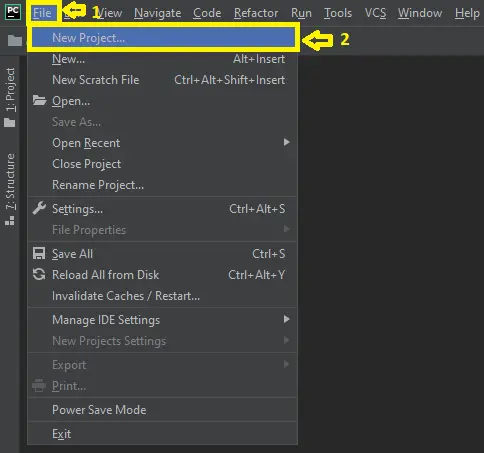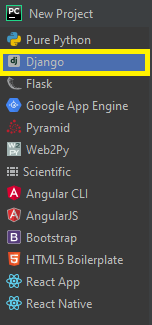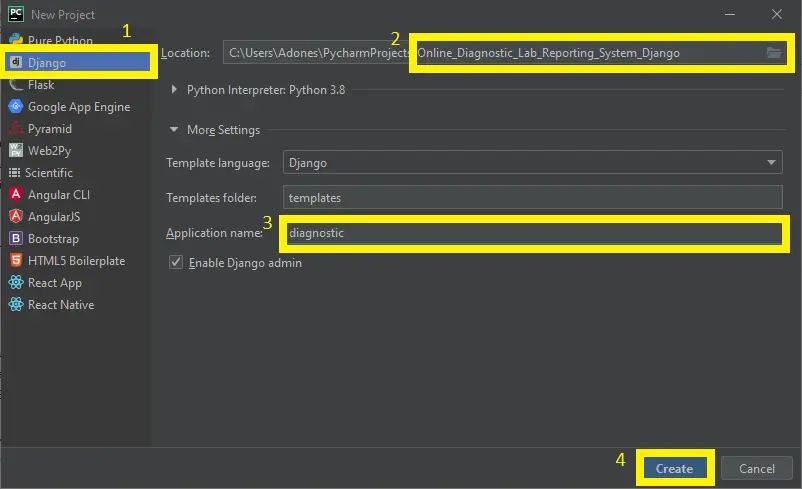Online Diagnostic Lab Reporting System in Django with Source Code
This Online Diagnostic Lab Reporting System Project in Django created based on python, Django, and SQLITE3 Database.
It’s an online diagnostic lab manager that displays a variety of diagnoses while working online. Patients can register on the site and log in with their username and password.
A Online Diagnostic Lab Reporting, Patients can now examine a variety of tests performed by the lab, as well as their fees, after registering with their address and contact information.
Patients can use the system to schedule tests such as CBC, Blood Glucose, KFT, and LFT. Hemoglobin, WBC, and other markers are included in the testing.
The Online Diagnostic Lab Reporting System in Django is an easy project for beginners to learn how to build a web-based python Django project.
We will provide you with the complete source code and database for the python project so that you can easily install it on your machine and learn how to program in Python Django.
To start creating a Online Diagnostic Lab Reporting System Project in Python Django, makes sure that you have PyCharm Professional IDE Installed in your computer.
This Online Diagnostic Lab Reporting System in Django Framework, Also includes a Download Source Code for free, just find the downloadable source code below and click download now.
Admin Features: Online Diagnostic Lab Reporting System in Django
- Login Page – The page where the system administrator enters their system credentials in order to gain access to the system’s administrative side.
- New Category Page – The page to which an administrator can add new category.
- Category List – The page on which the category can be viewed, modified, or deleted.
- New Test Page – The page to which an administrator can add new test.
- Test List – The page on which the test can be viewed, modified, or deleted.
| About Project | Project Details | Definition |
|---|---|---|
| Project Name | Online Diagnostic Lab Reporting System in Django | The goal of “ONLINE DIAGNOSTIC LAB REPORTINGSYSTEM” is to provide a user-friendly, rapid, and cost-effective web application to computerize the management of a diagnostic system. It is concerned with the gathering of patient information, diagnosis data, and so on. Previously, it was done by hand. The system’s main job is to register and store patient and staff information, to retrieve that information as needed, and to change that information meaningfully. |
| Python version (Recommended) | 3.8 Version | Python 3.8 introduces some new syntax to the language, as well as a few small modifications to existing behavior and, most importantly, a slew of performance improvements, following in the footsteps of the previous 3.7 version. |
| Programming Language Used | Python Django Language | Django is a high-level Python web framework for building safe and maintainable websites quickly. Django is a web framework built by experienced developers that takes care of a lot of the heavy lifting so you can focus on developing your app instead of reinventing the wheel. |
| Developer Name | itsourcecode.com | Free projects containing source code in Java, PHP, Python, Django, VB.Net, Visual Basic, C, C++, C#, Javascript, and other languages are available on this website. |
| IDE Tool (Recommended) | Sublime, Visual Studio, PyCharm | Sublime Text is a source code editor that is available for purchase. It comes with built-in support for a variety of programming and markup languages. Plugins, which are often community-built and maintained under free-software licenses, allow users to extend the functionality of the system. Sublime Text has a Python API to help with plugins. |
| Project Type | Web Application | A web application, unlike computer-based software programs that operate locally on the device’s operating system, is application software that runs on a web server. The user uses a web browser with an active network connection to access web apps. |
| Database | SQLite | SQLite is a programming language that is used to create embedded software for devices such as televisions, cell phones, and cameras. It can handle HTTP requests with low to medium traffic. SQLite has the ability to compress files into smaller bundles with less metadata. SQLite is a temporary dataset that is used within an application to process data. |
Customer Features: Online Diagnostic Lab Reporting System in Django
- Login Page – Customers enter their website credentials on this page to gain access to all of the website’s features.
- Register Page– The page where new customers created their login credentials for the website.
- Home Page– When customers visit the website, this is the system’s default page.
- Product View Page – The page on which the product’s specific information is shown, as well as the page on which the customer adds the product to his or her cart.
- Cart List Page– The page that lists the items that customers have chosen. This is the page where the customer can complete the order checkout process.
- My Order Page – The page that lists the customer’s orders.
Online Diagnostic Lab Reporting System in Django Steps on How to Create a Project
Time needed: 5 minutes
Here are the steps on how to create a Online Diagnostic Lab Reporting System in Django with Source Code.
- Step 1: Open file.
First , open “pycharm professional” after that click “file” and click “new project”.

- Step 2: Choose Django.
Next, after click “new project“, choose “Django” and click.

- Step 3: Select file location.
Then, select a file location wherever you want.

- Step 4: Create application name.
After that, name your application.

- Step 5: Click create.
Lastly, finish creating project by clicking “create” button.

- Step 6: Start Coding.
Finally, we will now start adding functionality to our Django Framework by adding some functional codes.
Functionality and Codes of the Online Diagnostic Lab Reporting System in Django
- Create template for the add category form in Online Diagnostic Lab Reporting System Project in Django.
In this section, we will learn on how create a templates for the add category. To start with, add the following code in your add_category.html under the folder of /templates/.
{% load static %}
<!DOCTYPE html>
<html lang="en">
<head>
<meta charset="UTF-8">
<meta name="viewport" content="width=device-width, initial-scale=1.0">
<meta http-equiv="X-UA-Compatible" content="ie=edge">
<title>Add Category | ODLRS</title>
<link rel="stylesheet" href="https://maxcdn.bootstrapcdn.com/bootstrap/4.0.0/css/bootstrap.min.css"
integrity="sha384-Gn5384xqQ1aoWXA+058RXPxPg6fy4IWvTNh0E263XmFcJlSAwiGgFAW/dAiS6JXm" crossorigin="anonymous" />
<link rel="stylesheet" type="text/css" href="{% static 'css/bootstrap.min.css' %}">
<link rel="stylesheet" type="text/css" href="{% static 'css/fakeLoader.min.css' %}">
<link rel="stylesheet" type="text/css" href="{% static 'css/style.css' %}">
<script src="{% static 'js/jquery.min.js' %}"></script>
</head>
<body class="common-bg">
<!-- loader -->
<div class="fakeLoader"></div>
<!-- loader -->
<nav class="navbar navbar-expand-lg navbar-dark bg-dark">
<div class="container">
<a class="navbar-brand text-white" href="#"><b>ODLRS</b></a>
<button class="navbar-toggler" type="button" data-toggle="collapse" data-target="#navbarSupportedContent"
aria-controls="navbarSupportedContent" aria-expanded="false" aria-label="Toggle navigation">
<span class="navbar-toggler-icon"></span>
</button>
<div class="collapse navbar-collapse" id="navbarSupportedContent">
<ul class="navbar-nav ml-auto">
<li class="nav-item user-profile">
<a class="nav-link d-flex dropdown-btn" href="#">
<img src="{% static 'images/admin-staff.png' %}" alt="" class="rounded-circle">
<span class=" dropdown-toggle text-white ml-2">Admin</span>
</a>
<ul class="dropdown">
<li class="text-center">
<img src="{% static 'images/admin-staff.png' %}" alt="" class="rounded-circle mb-2">
<a href="http://localhost:8000/admin-dashboard/labaid_admin_1">Admin Dashboard</a>
</li>
<div class="dropdown-divider"></div>
<li class="dropdown-item">
<a href="{% url 'diagnostic_centers:admin-logout' %}">Logout</a>
</li>
</ul>
</li>
</ul>
</div>
</div>
</nav>
<div class="container inner-content">
<div class="card-width">
<div class="card my-4">
<div class="card-header bg-dark text-center py-">
<h2 class="text-white mb-0 text-uppercase">Add Category</h2>
</div>
<div class="card-bottom-img"></div>
<div class="card-body">
<form method="post">
{% csrf_token %}
{{ category_add_form.as_p }}
<button class="btn btn-dark w-100 mt-4 " type="submit">ADD</button>
</form>
</div>
</div>
</div>
</div>
<div class="footer text-white text-center bg-dark py-3" style="position: relative">
<div class="d-box px-2">
<a class="text-white" href="{% url 'developers' %}" target="_blank" data-toggle="tooltip"
data-placement="top" title="About Developers">About Developers</a>
</div>
</div>
<script src="{% static 'js/fakeLoader.min.js' %}"></script>
<script>
$.fakeLoader();
</script>
<script>
$(document).ready(function () {
$(".dropdown-btn").click(function () {
$('.dropdown').toggle();
});
});
</script>
<script src="{% static 'js/bootstrap.min.js' %}"></script>
<script src="{% static 'js/main.js' %}"></script>
</body>
</html>- Create template for the add test form in Online Diagnostic Lab Reporting System Project in Django.
In this section, we will learn on how create a templates for the add test form. To start with, add the following code in your add_test.html under the folder of /templates/.
{% load static %}
<!DOCTYPE html>
<html lang="en">
<head>
<meta charset="UTF-8">
<meta name="viewport" content="width=device-width, initial-scale=1.0">
<meta http-equiv="X-UA-Compatible" content="ie=edge">
<title>Add Test | ODLRS</title>
<link rel="stylesheet" href="https://maxcdn.bootstrapcdn.com/bootstrap/4.0.0/css/bootstrap.min.css"
integrity="sha384-Gn5384xqQ1aoWXA+058RXPxPg6fy4IWvTNh0E263XmFcJlSAwiGgFAW/dAiS6JXm" crossorigin="anonymous" />
<link rel="stylesheet" type="text/css" href="{% static 'css/bootstrap.min.css' %}">
<link rel="stylesheet" type="text/css" href="{% static 'css/fakeLoader.min.css' %}">
<link rel="stylesheet" type="text/css" href="{% static 'css/style.css' %}">
<script src="{% static 'js/jquery.min.js' %}"></script>
</head>
<body class="common-bg">
<!-- loader -->
<div class="fakeLoader"></div>
<!-- loader -->
<nav class="navbar navbar-expand-lg navbar-dark bg-dark">
<div class="container">
<a class="navbar-brand text-white" href="#"><b>ODLRS</b></a>
<button class="navbar-toggler" type="button" data-toggle="collapse" data-target="#navbarSupportedContent"
aria-controls="navbarSupportedContent" aria-expanded="false" aria-label="Toggle navigation">
<span class="navbar-toggler-icon"></span>
</button>
<div class="collapse navbar-collapse" id="navbarSupportedContent">
<ul class="navbar-nav ml-auto">
<li class="nav-item user-profile">
<a class="nav-link d-flex dropdown-btn" href="#">
<img src="{% static 'images/admin-staff.png' %}" alt="" class="rounded-circle">
<span class=" dropdown-toggle text-white ml-2">Admin</span>
</a>
<ul class="dropdown">
<li class="text-center">
<img src="{% static 'images/admin-staff.png' %}" alt="" class="rounded-circle mb-2">
<a href="http://localhost:8000/admin-dashboard/labaid_admin_1">Admin Dashboard</a>
</li>
<div class="dropdown-divider"></div>
<li class="dropdown-item">
<a href="{% url 'diagnostic_centers:admin-logout' %}">Logout</a>
</li>
</ul>
</li>
</ul>
</div>
</div>
</nav>
<div class="container inner-conten">
<div class="card-width">
<div class="card card-form mb-5">
<div class="card-header bg-dark text-center py-">
<h2 class="text-white mb-0 text-uppercase"> Add Test </h2>
</div>
<div class="card-bottom-img"></div>
<div class="card-body">
<form method="post">
{% csrf_token %}
{{ test_add_form.as_p }}
<button class="btn btn-dark w-100 mt-3" type="submit">ADD</button>
</form>
</div>
</div>
</div>
</div>
<div class="footer bg-dark text-white text-center py-3">
<div class="d-box px-2">
<a class="text-white" href="{% url 'developers' %}" target="_blank" data-toggle="tooltip"
data-placement="top" title="About Developers">Online Diagnostic Lab Reporting System</a>
</div>
</div>
<script src="{% static 'js/fakeLoader.min.js' %}"></script>
<script>
$.fakeLoader();
</script>
<script>
$(document).ready(function () {
$(".dropdown-btn").click(function () {
$('.dropdown').toggle();
});
});
</script>
<script src="{% static 'js/bootstrap.min.js' %}"></script>
<script src="{% static 'js/main.js' %}"></script>
</body>
</html>- Create template for the payment method form in Online Diagnostic Lab Reporting System Project in Django.
In this section, we will learn on how create a templates for the confirmed payment method form. To start with, add the following code in your payment_method.html under the folder of /templates/.
{% extends 'base.html' %}
{% load static %}
{% block title %}
<title>Order</title>
{% endblock %}
{% block header %}
{% include 'components/header.html' %}
{% endblock %}
{% block content %}
<div class="container">
<div class="text-center">
<h1>Order By</h1>
</div>
<hr>
<div class="container">
<div class="row">
<div class="col-md-6 text-lg-right text-md-right">
<h5>Customer:</h5>
</div>
<div class="col-md-6">
<p>{{ customer.name }}</p>
</div>
</div>
<div class="row">
<div class="col-md-6 text-lg-right text-md-right">
<h5>Phone No:</h5>
</div>
<div class="col-md-6">
<p>{{ customer.PhoneNo }}</p>
</div>
</div>
<div class="row">
<div class="col-md-6 text-lg-right text-md-right">
<h5>Address:</h5>
</div>
<div class="col-md-6">
<p>{{ order.address }}</p>
</div>
</div>
<div class="row">
<div class="col-md-6 text-lg-right text-md-right">
<h5>Area:</h5>
</div>
<div class="col-md-6">
<p>{{ order.area.name }}, {{ order.area.city }}</p>
</div>
</div>
<div class="row">
<div class="col-md-6 text-lg-right text-md-right">
<h5>Type:</h5>
</div>
{% if order.frequency == '1' %}
<div class="col-md-6">
<p>Only Once</p>
</div>
{% elif order.frequency == '2' %}
<div class="col-md-6">
<p>Regular</p>
</div>
{% endif %}
</div>
<hr>
<div class="text-center">
<h1>Order Details</h1>
</div>
<hr>
{% for items in quantity %}
<div class="row">
<div class="col-md-6 text-lg-right text-md-right">
<h5>{{ items.0 }}</h5>
</div>
<div class="col-md-6">
<p>{{ items.1 }}</p>
</div>
</div>
{% endfor %}
<hr>
<div class="row">
<div class="col-md-6 text-lg-right text-md-right">
<h5>Total price : </h5>
</div>
<div class="col-md-6">
<h5>{{ price }}</h5>
</div>
</div>
<hr>
<form action="/customer/order-confirmed/" method="post">
{% csrf_token %}
<div class="text-center">
<button type="submit" value="{{ order }}" class="btn btn-dark" name="order">Confirm</button>
</div>
</form>
</div>
</div>
{% endblock %}
{% block footer %}
{% include 'components/footer.html' %}
{% endblock %}Downloadable Source Code Below
Anyway, if you want to level up your programming knowledge, especially python, try this new article I’ve made for you Best Python Projects with source code for Beginners.
But If you’re going to focus on web development using Django, you can download here from our list of Best Django Projects with source code based on real-world projects.
How To Run The Online Diagnostic Lab Reporting System in Django?
- Step 1: Extract/unzip the file
- Step 2: Go inside the project folder, open cmd and type the following commands to install Django Framework and run the webserver:
- pip install -r requirements.txt
- python manage.py migrate
- python manage.py runserver
- Step 3: Finally, open the browser and go to http://127.0.0.1:8000/
Summary
In summary, this Online Diagnostic Lab Reporting System in Django with Source Code can be useful to students or professional who wants to learn python programming language.
This project can also be modified to fit your personal requirements. Hope this project will help you to improve your skills. Happy Coding!
- How To Make A Point Of Sale System In Python
- Best Python Projects for Beginners
- Python MySQL Connection: Simple Python Step by Step Guide
- Python PIP Command Set-up / Fix: Step by Step Guide
- Random Password Generator in Python Projects With Source Code
- Python Range Function | Range in Python Explained with Examples
- School Management System Project In Django With Source Code
- Django Login And Registration With Source Code
- CRUD App In Django With Source Code
- Drag And Drop JavaScript With Source Code
- Todo List App Django With Source Code
Inquiries
If you have any questions or suggestions about Online Diagnostic Lab Reporting System in Django with Source Code, please feel free to leave a comment below.






hello sir,i cannot run your project please could you help me to advice.
what is the error?